GDPM-510: Implementation of Risk Management Framework Report
VerifiedAdded on 2022/09/14
|9
|2080
|17
Report
AI Summary
This report, titled "Establishment of an organizational risk management framework," analyzes the implementation of a corporate risk management framework for a toll road construction project in Indonesia. It begins with an analysis of the 7 W's (Where, Who, Why, What, Which way, Wherewithal, and When) to understand the project's context, stakeholders, and objectives. The report then assesses the organization's maturity level in risk management across five levels, identifying responsibilities and procedures at each stage. A critical evaluation of the existing risk management framework is provided, highlighting both its strengths, such as categorizing risks, and weaknesses, like the lack of defined stakeholder responsibilities and mitigation strategies. Finally, the report analyzes the contractual instruments used, emphasizing the importance of managing uncertainties through stakeholder management and resource allocation to prevent project failures. The report draws on academic sources to support its findings and recommendations, offering a comprehensive overview of risk management principles and their application in a real-world construction scenario.
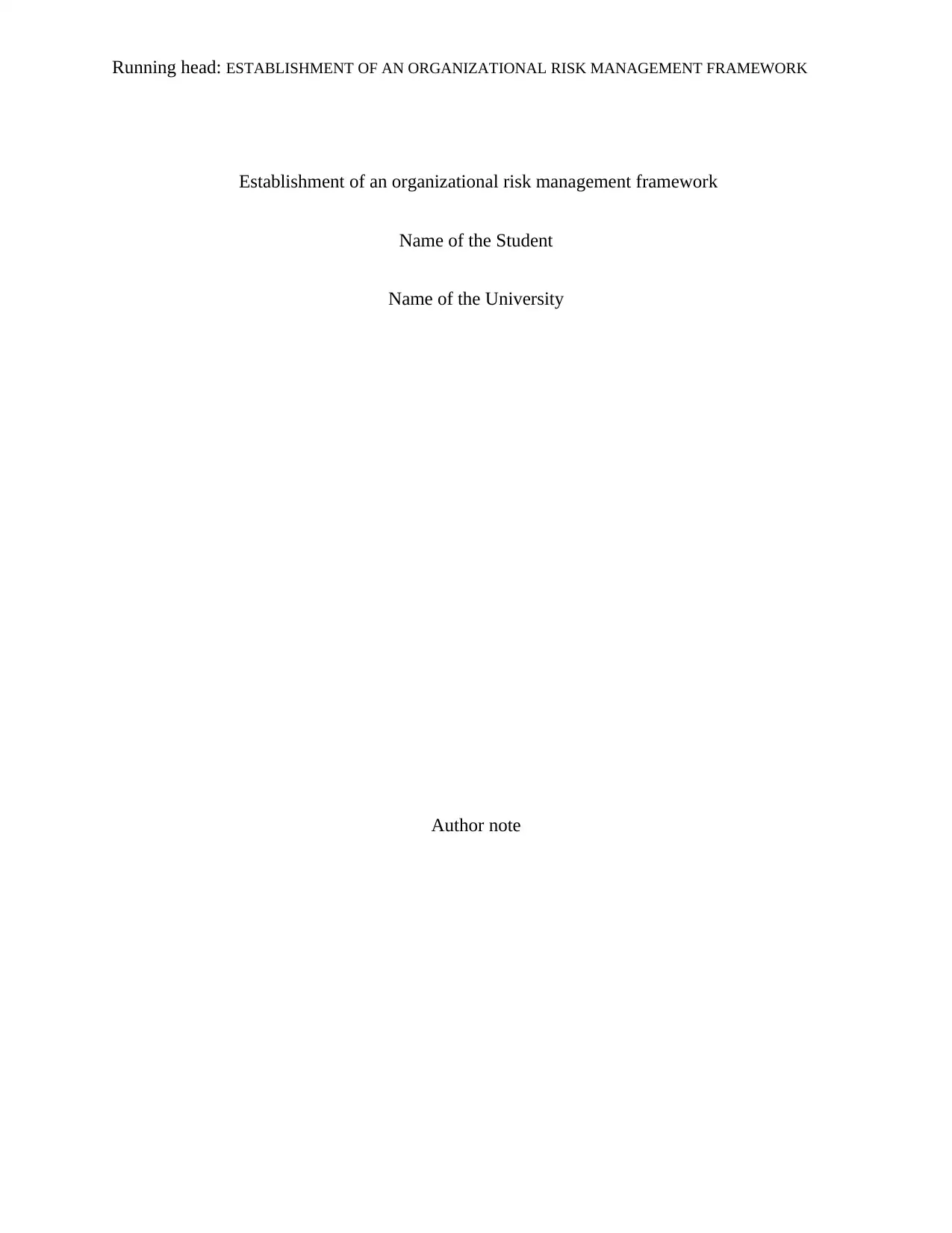
Running head: ESTABLISHMENT OF AN ORGANIZATIONAL RISK MANAGEMENT FRAMEWORK
Establishment of an organizational risk management framework
Name of the Student
Name of the University
Author note
Establishment of an organizational risk management framework
Name of the Student
Name of the University
Author note
Paraphrase This Document
Need a fresh take? Get an instant paraphrase of this document with our AI Paraphraser
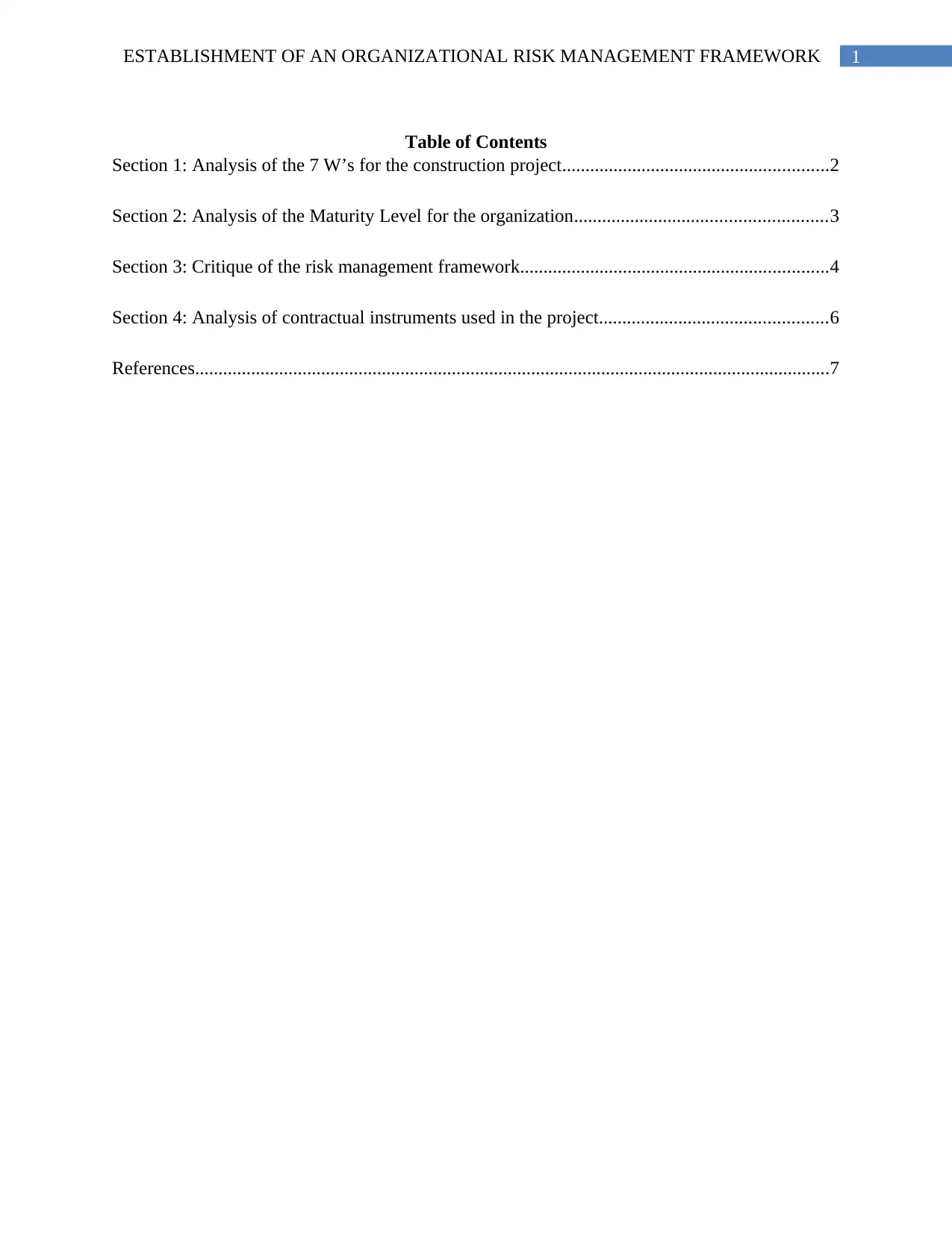
1ESTABLISHMENT OF AN ORGANIZATIONAL RISK MANAGEMENT FRAMEWORK
Table of Contents
Section 1: Analysis of the 7 W’s for the construction project.........................................................2
Section 2: Analysis of the Maturity Level for the organization......................................................3
Section 3: Critique of the risk management framework..................................................................4
Section 4: Analysis of contractual instruments used in the project.................................................6
References........................................................................................................................................7
Table of Contents
Section 1: Analysis of the 7 W’s for the construction project.........................................................2
Section 2: Analysis of the Maturity Level for the organization......................................................3
Section 3: Critique of the risk management framework..................................................................4
Section 4: Analysis of contractual instruments used in the project.................................................6
References........................................................................................................................................7
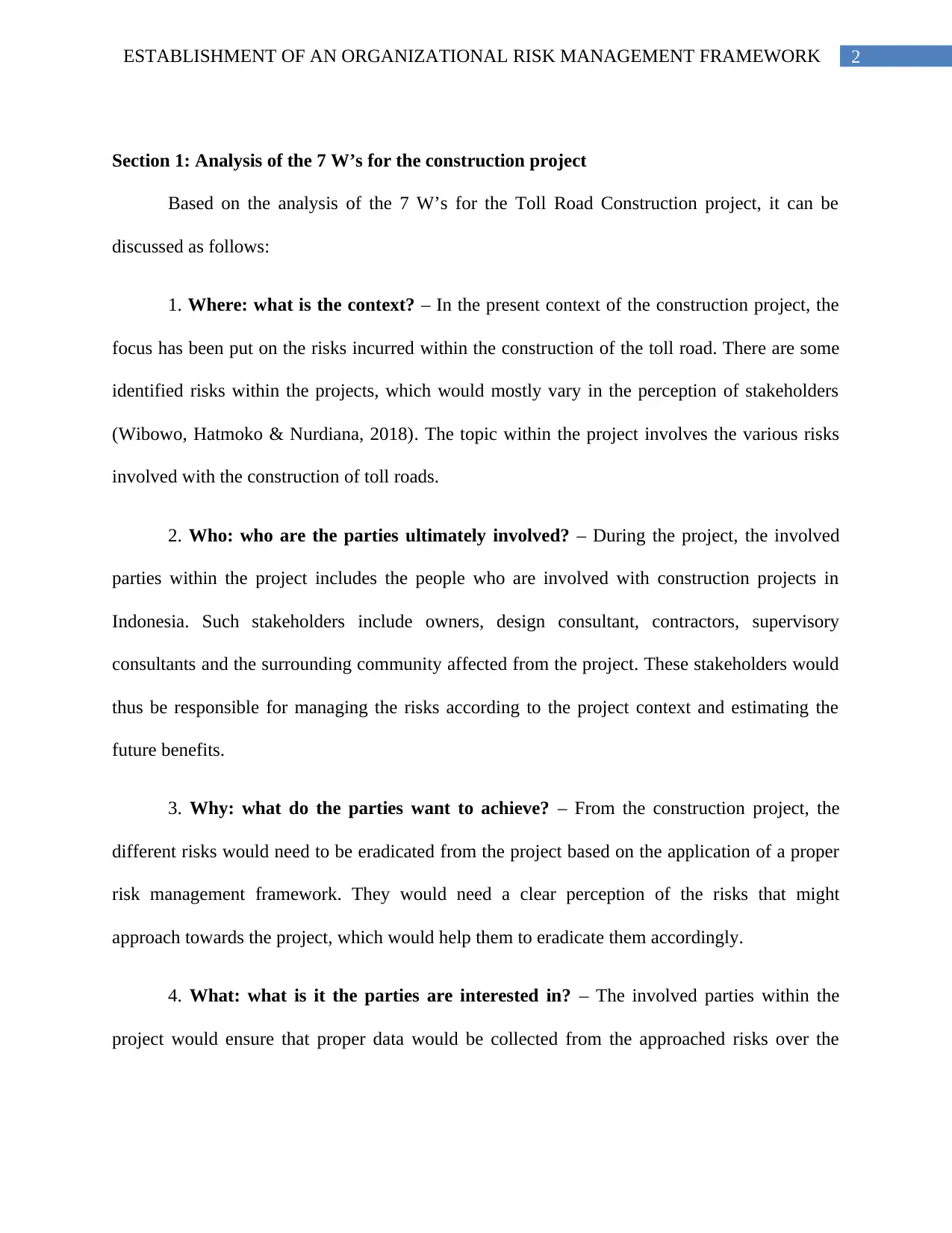
2ESTABLISHMENT OF AN ORGANIZATIONAL RISK MANAGEMENT FRAMEWORK
Section 1: Analysis of the 7 W’s for the construction project
Based on the analysis of the 7 W’s for the Toll Road Construction project, it can be
discussed as follows:
1. Where: what is the context? – In the present context of the construction project, the
focus has been put on the risks incurred within the construction of the toll road. There are some
identified risks within the projects, which would mostly vary in the perception of stakeholders
(Wibowo, Hatmoko & Nurdiana, 2018). The topic within the project involves the various risks
involved with the construction of toll roads.
2. Who: who are the parties ultimately involved? – During the project, the involved
parties within the project includes the people who are involved with construction projects in
Indonesia. Such stakeholders include owners, design consultant, contractors, supervisory
consultants and the surrounding community affected from the project. These stakeholders would
thus be responsible for managing the risks according to the project context and estimating the
future benefits.
3. Why: what do the parties want to achieve? – From the construction project, the
different risks would need to be eradicated from the project based on the application of a proper
risk management framework. They would need a clear perception of the risks that might
approach towards the project, which would help them to eradicate them accordingly.
4. What: what is it the parties are interested in? – The involved parties within the
project would ensure that proper data would be collected from the approached risks over the
Section 1: Analysis of the 7 W’s for the construction project
Based on the analysis of the 7 W’s for the Toll Road Construction project, it can be
discussed as follows:
1. Where: what is the context? – In the present context of the construction project, the
focus has been put on the risks incurred within the construction of the toll road. There are some
identified risks within the projects, which would mostly vary in the perception of stakeholders
(Wibowo, Hatmoko & Nurdiana, 2018). The topic within the project involves the various risks
involved with the construction of toll roads.
2. Who: who are the parties ultimately involved? – During the project, the involved
parties within the project includes the people who are involved with construction projects in
Indonesia. Such stakeholders include owners, design consultant, contractors, supervisory
consultants and the surrounding community affected from the project. These stakeholders would
thus be responsible for managing the risks according to the project context and estimating the
future benefits.
3. Why: what do the parties want to achieve? – From the construction project, the
different risks would need to be eradicated from the project based on the application of a proper
risk management framework. They would need a clear perception of the risks that might
approach towards the project, which would help them to eradicate them accordingly.
4. What: what is it the parties are interested in? – The involved parties within the
project would ensure that proper data would be collected from the approached risks over the
⊘ This is a preview!⊘
Do you want full access?
Subscribe today to unlock all pages.

Trusted by 1+ million students worldwide
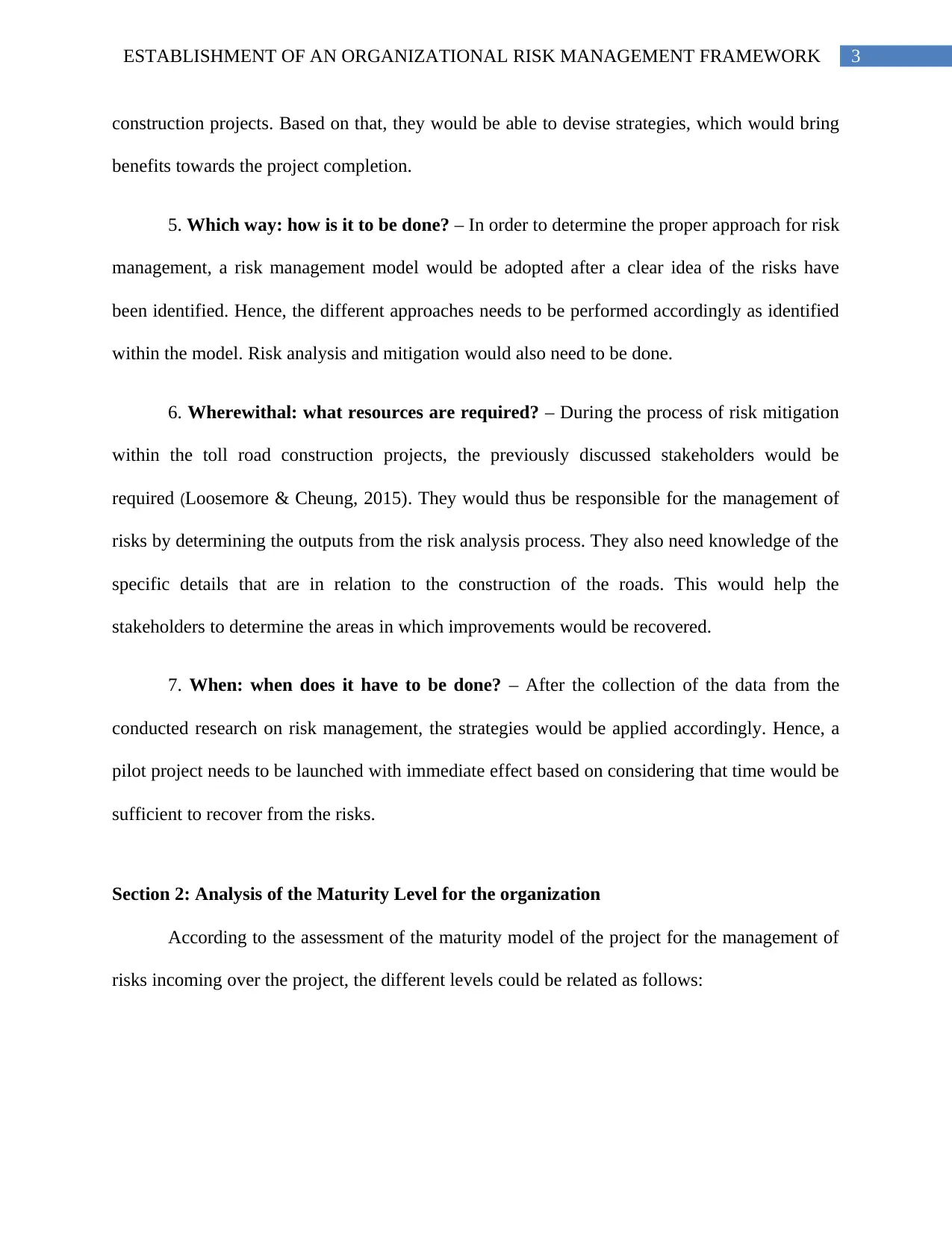
3ESTABLISHMENT OF AN ORGANIZATIONAL RISK MANAGEMENT FRAMEWORK
construction projects. Based on that, they would be able to devise strategies, which would bring
benefits towards the project completion.
5. Which way: how is it to be done? – In order to determine the proper approach for risk
management, a risk management model would be adopted after a clear idea of the risks have
been identified. Hence, the different approaches needs to be performed accordingly as identified
within the model. Risk analysis and mitigation would also need to be done.
6. Wherewithal: what resources are required? – During the process of risk mitigation
within the toll road construction projects, the previously discussed stakeholders would be
required (Loosemore & Cheung, 2015). They would thus be responsible for the management of
risks by determining the outputs from the risk analysis process. They also need knowledge of the
specific details that are in relation to the construction of the roads. This would help the
stakeholders to determine the areas in which improvements would be recovered.
7. When: when does it have to be done? – After the collection of the data from the
conducted research on risk management, the strategies would be applied accordingly. Hence, a
pilot project needs to be launched with immediate effect based on considering that time would be
sufficient to recover from the risks.
Section 2: Analysis of the Maturity Level for the organization
According to the assessment of the maturity model of the project for the management of
risks incoming over the project, the different levels could be related as follows:
construction projects. Based on that, they would be able to devise strategies, which would bring
benefits towards the project completion.
5. Which way: how is it to be done? – In order to determine the proper approach for risk
management, a risk management model would be adopted after a clear idea of the risks have
been identified. Hence, the different approaches needs to be performed accordingly as identified
within the model. Risk analysis and mitigation would also need to be done.
6. Wherewithal: what resources are required? – During the process of risk mitigation
within the toll road construction projects, the previously discussed stakeholders would be
required (Loosemore & Cheung, 2015). They would thus be responsible for the management of
risks by determining the outputs from the risk analysis process. They also need knowledge of the
specific details that are in relation to the construction of the roads. This would help the
stakeholders to determine the areas in which improvements would be recovered.
7. When: when does it have to be done? – After the collection of the data from the
conducted research on risk management, the strategies would be applied accordingly. Hence, a
pilot project needs to be launched with immediate effect based on considering that time would be
sufficient to recover from the risks.
Section 2: Analysis of the Maturity Level for the organization
According to the assessment of the maturity model of the project for the management of
risks incoming over the project, the different levels could be related as follows:
Paraphrase This Document
Need a fresh take? Get an instant paraphrase of this document with our AI Paraphraser
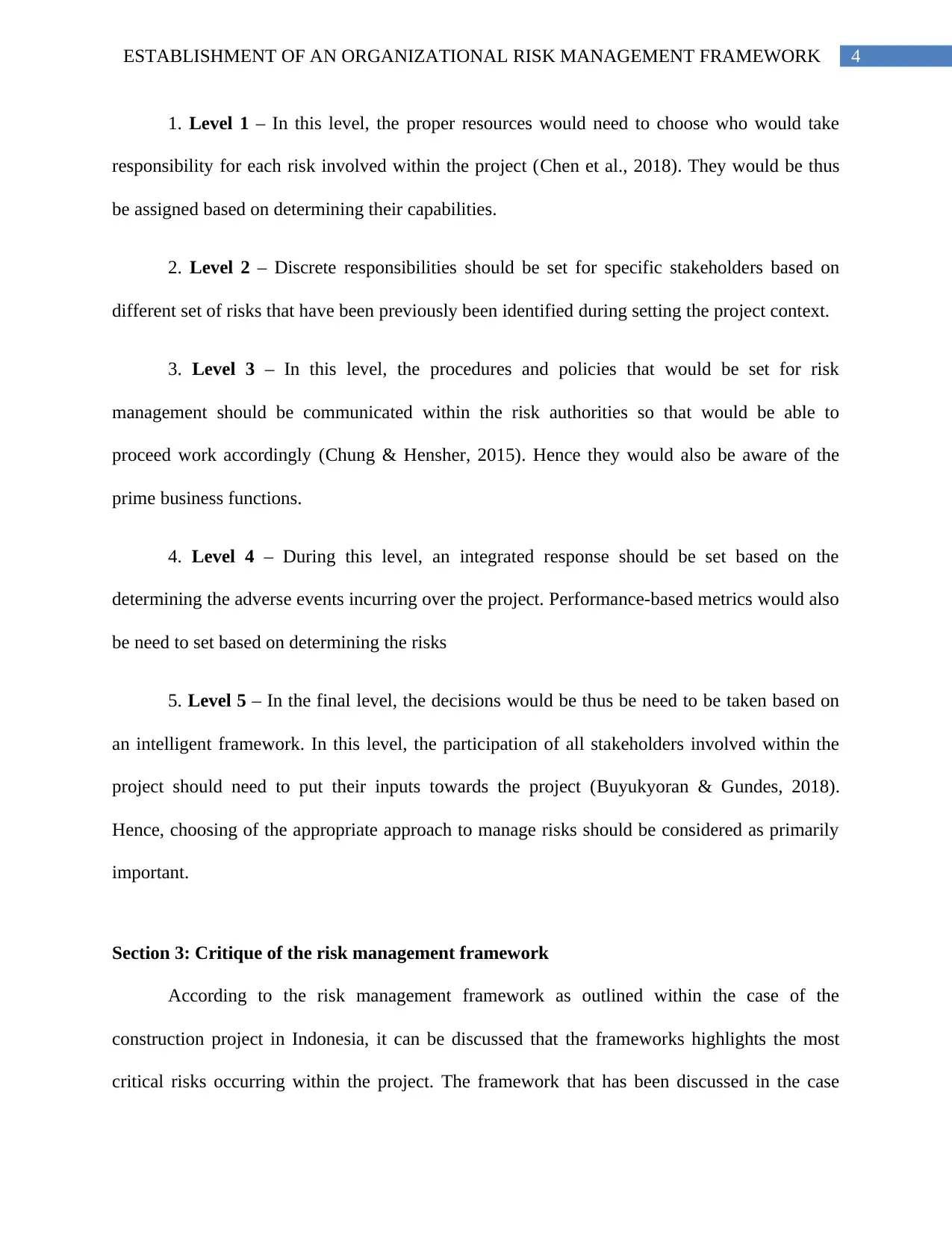
4ESTABLISHMENT OF AN ORGANIZATIONAL RISK MANAGEMENT FRAMEWORK
1. Level 1 – In this level, the proper resources would need to choose who would take
responsibility for each risk involved within the project (Chen et al., 2018). They would be thus
be assigned based on determining their capabilities.
2. Level 2 – Discrete responsibilities should be set for specific stakeholders based on
different set of risks that have been previously been identified during setting the project context.
3. Level 3 – In this level, the procedures and policies that would be set for risk
management should be communicated within the risk authorities so that would be able to
proceed work accordingly (Chung & Hensher, 2015). Hence they would also be aware of the
prime business functions.
4. Level 4 – During this level, an integrated response should be set based on the
determining the adverse events incurring over the project. Performance-based metrics would also
be need to set based on determining the risks
5. Level 5 – In the final level, the decisions would be thus be need to be taken based on
an intelligent framework. In this level, the participation of all stakeholders involved within the
project should need to put their inputs towards the project (Buyukyoran & Gundes, 2018).
Hence, choosing of the appropriate approach to manage risks should be considered as primarily
important.
Section 3: Critique of the risk management framework
According to the risk management framework as outlined within the case of the
construction project in Indonesia, it can be discussed that the frameworks highlights the most
critical risks occurring within the project. The framework that has been discussed in the case
1. Level 1 – In this level, the proper resources would need to choose who would take
responsibility for each risk involved within the project (Chen et al., 2018). They would be thus
be assigned based on determining their capabilities.
2. Level 2 – Discrete responsibilities should be set for specific stakeholders based on
different set of risks that have been previously been identified during setting the project context.
3. Level 3 – In this level, the procedures and policies that would be set for risk
management should be communicated within the risk authorities so that would be able to
proceed work accordingly (Chung & Hensher, 2015). Hence they would also be aware of the
prime business functions.
4. Level 4 – During this level, an integrated response should be set based on the
determining the adverse events incurring over the project. Performance-based metrics would also
be need to set based on determining the risks
5. Level 5 – In the final level, the decisions would be thus be need to be taken based on
an intelligent framework. In this level, the participation of all stakeholders involved within the
project should need to put their inputs towards the project (Buyukyoran & Gundes, 2018).
Hence, choosing of the appropriate approach to manage risks should be considered as primarily
important.
Section 3: Critique of the risk management framework
According to the risk management framework as outlined within the case of the
construction project in Indonesia, it can be discussed that the frameworks highlights the most
critical risks occurring within the project. The framework that has been discussed in the case
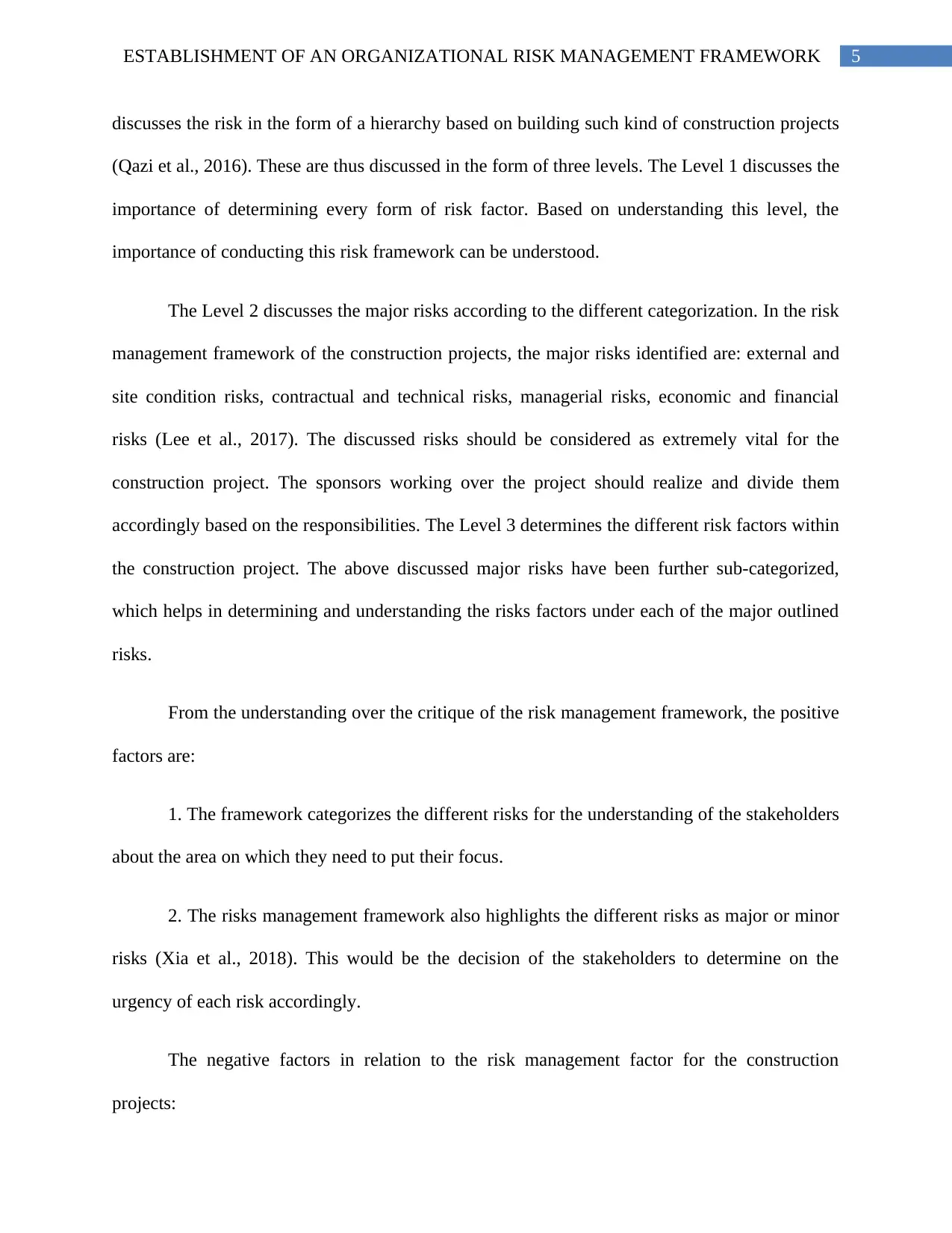
5ESTABLISHMENT OF AN ORGANIZATIONAL RISK MANAGEMENT FRAMEWORK
discusses the risk in the form of a hierarchy based on building such kind of construction projects
(Qazi et al., 2016). These are thus discussed in the form of three levels. The Level 1 discusses the
importance of determining every form of risk factor. Based on understanding this level, the
importance of conducting this risk framework can be understood.
The Level 2 discusses the major risks according to the different categorization. In the risk
management framework of the construction projects, the major risks identified are: external and
site condition risks, contractual and technical risks, managerial risks, economic and financial
risks (Lee et al., 2017). The discussed risks should be considered as extremely vital for the
construction project. The sponsors working over the project should realize and divide them
accordingly based on the responsibilities. The Level 3 determines the different risk factors within
the construction project. The above discussed major risks have been further sub-categorized,
which helps in determining and understanding the risks factors under each of the major outlined
risks.
From the understanding over the critique of the risk management framework, the positive
factors are:
1. The framework categorizes the different risks for the understanding of the stakeholders
about the area on which they need to put their focus.
2. The risks management framework also highlights the different risks as major or minor
risks (Xia et al., 2018). This would be the decision of the stakeholders to determine on the
urgency of each risk accordingly.
The negative factors in relation to the risk management factor for the construction
projects:
discusses the risk in the form of a hierarchy based on building such kind of construction projects
(Qazi et al., 2016). These are thus discussed in the form of three levels. The Level 1 discusses the
importance of determining every form of risk factor. Based on understanding this level, the
importance of conducting this risk framework can be understood.
The Level 2 discusses the major risks according to the different categorization. In the risk
management framework of the construction projects, the major risks identified are: external and
site condition risks, contractual and technical risks, managerial risks, economic and financial
risks (Lee et al., 2017). The discussed risks should be considered as extremely vital for the
construction project. The sponsors working over the project should realize and divide them
accordingly based on the responsibilities. The Level 3 determines the different risk factors within
the construction project. The above discussed major risks have been further sub-categorized,
which helps in determining and understanding the risks factors under each of the major outlined
risks.
From the understanding over the critique of the risk management framework, the positive
factors are:
1. The framework categorizes the different risks for the understanding of the stakeholders
about the area on which they need to put their focus.
2. The risks management framework also highlights the different risks as major or minor
risks (Xia et al., 2018). This would be the decision of the stakeholders to determine on the
urgency of each risk accordingly.
The negative factors in relation to the risk management factor for the construction
projects:
⊘ This is a preview!⊘
Do you want full access?
Subscribe today to unlock all pages.

Trusted by 1+ million students worldwide
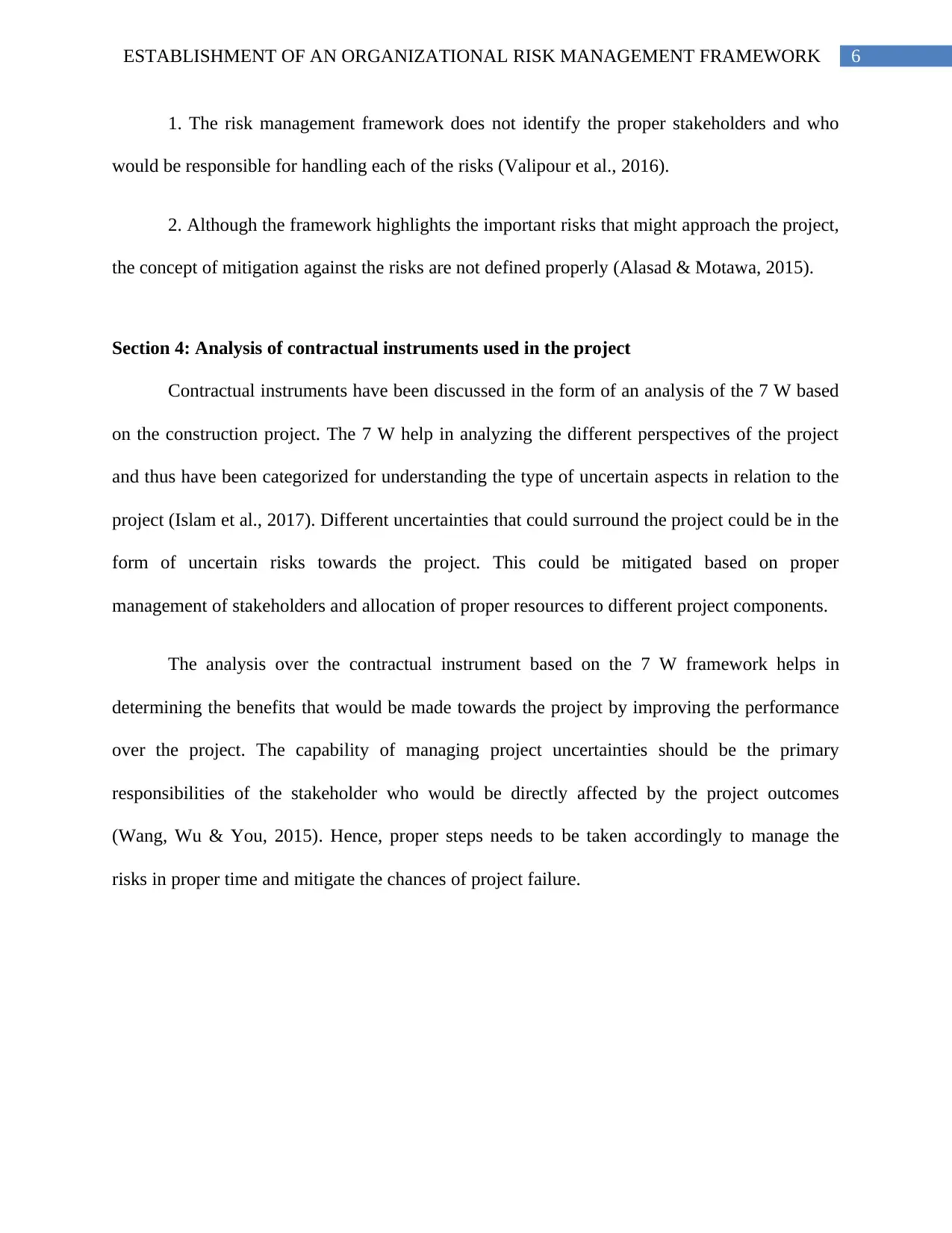
6ESTABLISHMENT OF AN ORGANIZATIONAL RISK MANAGEMENT FRAMEWORK
1. The risk management framework does not identify the proper stakeholders and who
would be responsible for handling each of the risks (Valipour et al., 2016).
2. Although the framework highlights the important risks that might approach the project,
the concept of mitigation against the risks are not defined properly (Alasad & Motawa, 2015).
Section 4: Analysis of contractual instruments used in the project
Contractual instruments have been discussed in the form of an analysis of the 7 W based
on the construction project. The 7 W help in analyzing the different perspectives of the project
and thus have been categorized for understanding the type of uncertain aspects in relation to the
project (Islam et al., 2017). Different uncertainties that could surround the project could be in the
form of uncertain risks towards the project. This could be mitigated based on proper
management of stakeholders and allocation of proper resources to different project components.
The analysis over the contractual instrument based on the 7 W framework helps in
determining the benefits that would be made towards the project by improving the performance
over the project. The capability of managing project uncertainties should be the primary
responsibilities of the stakeholder who would be directly affected by the project outcomes
(Wang, Wu & You, 2015). Hence, proper steps needs to be taken accordingly to manage the
risks in proper time and mitigate the chances of project failure.
1. The risk management framework does not identify the proper stakeholders and who
would be responsible for handling each of the risks (Valipour et al., 2016).
2. Although the framework highlights the important risks that might approach the project,
the concept of mitigation against the risks are not defined properly (Alasad & Motawa, 2015).
Section 4: Analysis of contractual instruments used in the project
Contractual instruments have been discussed in the form of an analysis of the 7 W based
on the construction project. The 7 W help in analyzing the different perspectives of the project
and thus have been categorized for understanding the type of uncertain aspects in relation to the
project (Islam et al., 2017). Different uncertainties that could surround the project could be in the
form of uncertain risks towards the project. This could be mitigated based on proper
management of stakeholders and allocation of proper resources to different project components.
The analysis over the contractual instrument based on the 7 W framework helps in
determining the benefits that would be made towards the project by improving the performance
over the project. The capability of managing project uncertainties should be the primary
responsibilities of the stakeholder who would be directly affected by the project outcomes
(Wang, Wu & You, 2015). Hence, proper steps needs to be taken accordingly to manage the
risks in proper time and mitigate the chances of project failure.
Paraphrase This Document
Need a fresh take? Get an instant paraphrase of this document with our AI Paraphraser
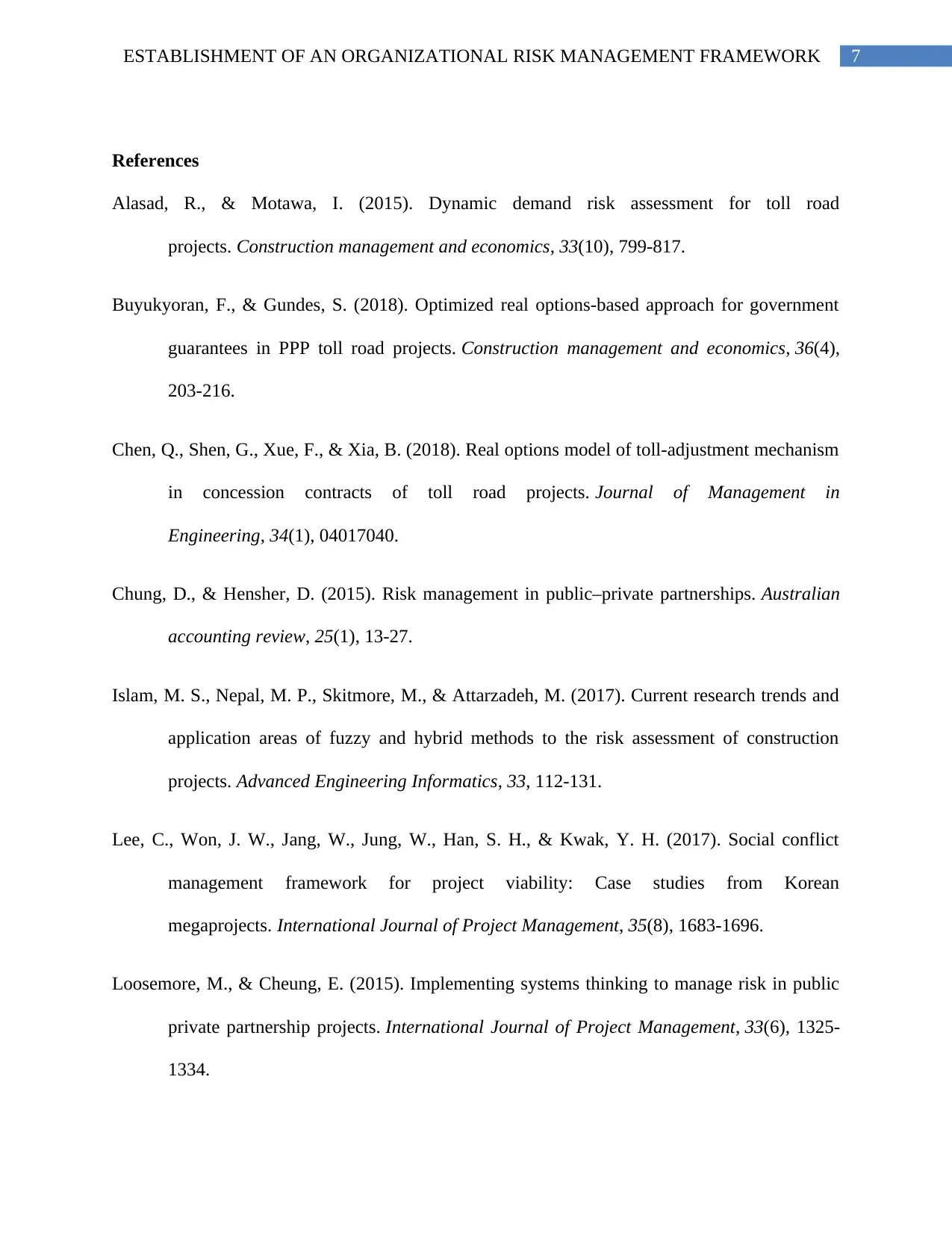
7ESTABLISHMENT OF AN ORGANIZATIONAL RISK MANAGEMENT FRAMEWORK
References
Alasad, R., & Motawa, I. (2015). Dynamic demand risk assessment for toll road
projects. Construction management and economics, 33(10), 799-817.
Buyukyoran, F., & Gundes, S. (2018). Optimized real options-based approach for government
guarantees in PPP toll road projects. Construction management and economics, 36(4),
203-216.
Chen, Q., Shen, G., Xue, F., & Xia, B. (2018). Real options model of toll-adjustment mechanism
in concession contracts of toll road projects. Journal of Management in
Engineering, 34(1), 04017040.
Chung, D., & Hensher, D. (2015). Risk management in public–private partnerships. Australian
accounting review, 25(1), 13-27.
Islam, M. S., Nepal, M. P., Skitmore, M., & Attarzadeh, M. (2017). Current research trends and
application areas of fuzzy and hybrid methods to the risk assessment of construction
projects. Advanced Engineering Informatics, 33, 112-131.
Lee, C., Won, J. W., Jang, W., Jung, W., Han, S. H., & Kwak, Y. H. (2017). Social conflict
management framework for project viability: Case studies from Korean
megaprojects. International Journal of Project Management, 35(8), 1683-1696.
Loosemore, M., & Cheung, E. (2015). Implementing systems thinking to manage risk in public
private partnership projects. International Journal of Project Management, 33(6), 1325-
1334.
References
Alasad, R., & Motawa, I. (2015). Dynamic demand risk assessment for toll road
projects. Construction management and economics, 33(10), 799-817.
Buyukyoran, F., & Gundes, S. (2018). Optimized real options-based approach for government
guarantees in PPP toll road projects. Construction management and economics, 36(4),
203-216.
Chen, Q., Shen, G., Xue, F., & Xia, B. (2018). Real options model of toll-adjustment mechanism
in concession contracts of toll road projects. Journal of Management in
Engineering, 34(1), 04017040.
Chung, D., & Hensher, D. (2015). Risk management in public–private partnerships. Australian
accounting review, 25(1), 13-27.
Islam, M. S., Nepal, M. P., Skitmore, M., & Attarzadeh, M. (2017). Current research trends and
application areas of fuzzy and hybrid methods to the risk assessment of construction
projects. Advanced Engineering Informatics, 33, 112-131.
Lee, C., Won, J. W., Jang, W., Jung, W., Han, S. H., & Kwak, Y. H. (2017). Social conflict
management framework for project viability: Case studies from Korean
megaprojects. International Journal of Project Management, 35(8), 1683-1696.
Loosemore, M., & Cheung, E. (2015). Implementing systems thinking to manage risk in public
private partnership projects. International Journal of Project Management, 33(6), 1325-
1334.
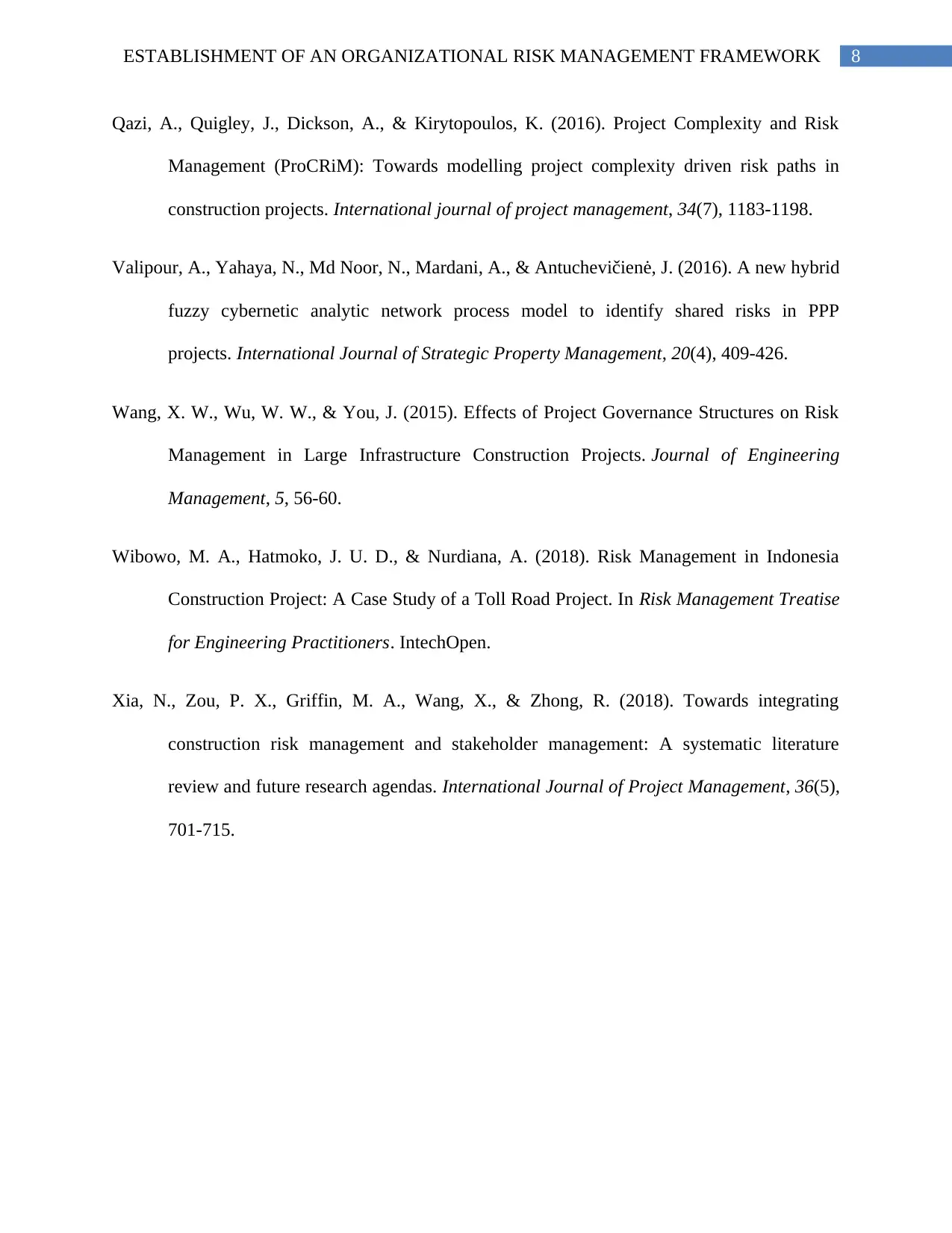
8ESTABLISHMENT OF AN ORGANIZATIONAL RISK MANAGEMENT FRAMEWORK
Qazi, A., Quigley, J., Dickson, A., & Kirytopoulos, K. (2016). Project Complexity and Risk
Management (ProCRiM): Towards modelling project complexity driven risk paths in
construction projects. International journal of project management, 34(7), 1183-1198.
Valipour, A., Yahaya, N., Md Noor, N., Mardani, A., & Antuchevičienė, J. (2016). A new hybrid
fuzzy cybernetic analytic network process model to identify shared risks in PPP
projects. International Journal of Strategic Property Management, 20(4), 409-426.
Wang, X. W., Wu, W. W., & You, J. (2015). Effects of Project Governance Structures on Risk
Management in Large Infrastructure Construction Projects. Journal of Engineering
Management, 5, 56-60.
Wibowo, M. A., Hatmoko, J. U. D., & Nurdiana, A. (2018). Risk Management in Indonesia
Construction Project: A Case Study of a Toll Road Project. In Risk Management Treatise
for Engineering Practitioners. IntechOpen.
Xia, N., Zou, P. X., Griffin, M. A., Wang, X., & Zhong, R. (2018). Towards integrating
construction risk management and stakeholder management: A systematic literature
review and future research agendas. International Journal of Project Management, 36(5),
701-715.
Qazi, A., Quigley, J., Dickson, A., & Kirytopoulos, K. (2016). Project Complexity and Risk
Management (ProCRiM): Towards modelling project complexity driven risk paths in
construction projects. International journal of project management, 34(7), 1183-1198.
Valipour, A., Yahaya, N., Md Noor, N., Mardani, A., & Antuchevičienė, J. (2016). A new hybrid
fuzzy cybernetic analytic network process model to identify shared risks in PPP
projects. International Journal of Strategic Property Management, 20(4), 409-426.
Wang, X. W., Wu, W. W., & You, J. (2015). Effects of Project Governance Structures on Risk
Management in Large Infrastructure Construction Projects. Journal of Engineering
Management, 5, 56-60.
Wibowo, M. A., Hatmoko, J. U. D., & Nurdiana, A. (2018). Risk Management in Indonesia
Construction Project: A Case Study of a Toll Road Project. In Risk Management Treatise
for Engineering Practitioners. IntechOpen.
Xia, N., Zou, P. X., Griffin, M. A., Wang, X., & Zhong, R. (2018). Towards integrating
construction risk management and stakeholder management: A systematic literature
review and future research agendas. International Journal of Project Management, 36(5),
701-715.
⊘ This is a preview!⊘
Do you want full access?
Subscribe today to unlock all pages.

Trusted by 1+ million students worldwide
1 out of 9
Related Documents
Your All-in-One AI-Powered Toolkit for Academic Success.
+13062052269
info@desklib.com
Available 24*7 on WhatsApp / Email
![[object Object]](/_next/static/media/star-bottom.7253800d.svg)
Unlock your academic potential
Copyright © 2020–2025 A2Z Services. All Rights Reserved. Developed and managed by ZUCOL.





